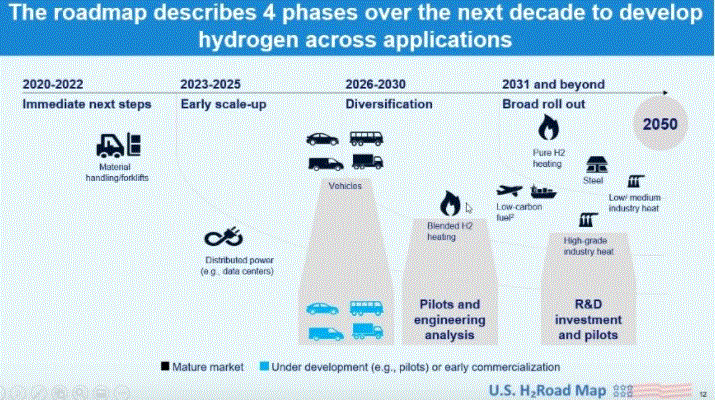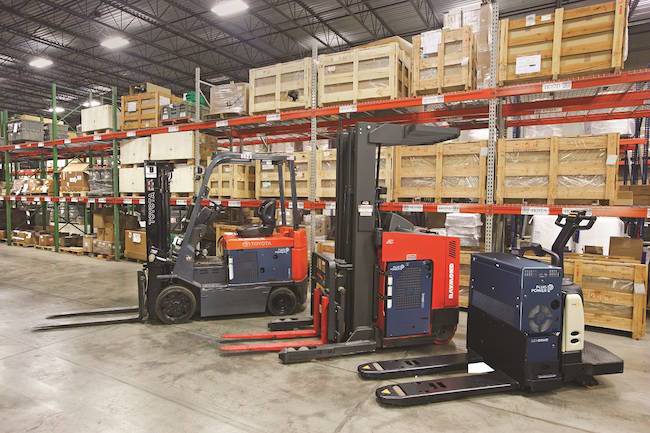A new report highlights the massive potential to decarbonize transport, industry and power grids — and the massive investments needed to get there.
By: JEFF ST. JOHN
View the original article here

The U.S. needs a massive green hydrogen industry to decarbonize its electricity, transportation and industrial sectors, and major investments and policy changes today to enable it to grow to its full potential in the decades to come.
So says a new report sponsored by major oil companies, automakers, hydrogen producers and fuel cell manufacturers pushing U.S. policymakers to follow the lead of the European Union in making a major commitment to building the infrastructure to grow its green hydrogen capacity.
The Roadmap to a U.S. Hydrogen Economy report forecasts that hydrogen from low-carbon sources could supply roughly 14 percent of the country’s energy needs by 2050, including hard-to-electrify sectors now dependent on natural gas such as high-heat industrial processes and manufacturing fertilizer.
Hydrogen to power fuel cells will also augment battery-powered vehicles in decarbonizing the transportation sector, particularly for vehicles requiring long ranges and fast refueling times such as long-haul trucks, said Jack Brouwer, a professor at the University of California at Irvine and associate director of the National Fuel Cell Research Center, in a Monday webinar introducing the report.
Meanwhile, wind, solar and nuclear power that might otherwise be forced to curtail generation when the power grid doesn’t need it could be used to electrolyze water to generate hydrogen that can be stored to power natural-gas-fired turbines needed for grid reliability or on-site fuel cells to maintain continuous power at data centers, hospitals and other critical sites, he said.
The report, prepared by consultancy firm McKinsey, is “agnostic” as to how this future hydrogen supply is generated, “as long as it’s low-carbon,” Brouwer said. Beyond electrolysis via zero-carbon electricity, that could include steam reforming of natural gas — the way most of today’s hydrogen supply is made — using carbon capture and storage to reduce its greenhouse gas impact, or employing less fully developed methods such as waste gasification, he said.
The U.S. already generates about 11.4 million metric tons of hydrogen per year, with an estimated value of about $17.6 billion. But reaching the report’s targets could drive about $140 billion per year in revenue and support 700,000 jobs by 2030, and about $750 billion per year in revenue and a cumulative 3.4 million jobs by 2050, it states.
The U.S. lags behind China, Japan and the European Union in infrastructure and research investments to reach this potential. Government and industry investment in hydrogen as an energy carrier adds up to $2 billion per year in Asia and the European Union, the report finds, while U.S. Department of Energy funding for hydrogen and fuel cells has ranged from approximately $100 million to $280 million per year over the last decade.
A roadmap for green hydrogen expansion
The report doesn’t set specific dollar targets for U.S. investment. But it highlights the need for capital to build the hydrogen production and transport infrastructure to carry it to end users, incentives to stimulate private-sector investment, codes and standards to regulate a growing supply chain, and research into still-nascent technologies.
It also lays out a phased approach for building on existing hydrogen use cases to expand to new ones. Experience with the roughly 25,000 fuel cell-powered forklifts in use in the U.S. will enable expansion to larger classes of vehicles, for example, and fuel cells being used for on-site power at data centers can serve as models for integrating hydrogen into large-scale generation.

Major challenges lie ahead of this growth, Brouwer said. To reach the report’s goals, the number of fuel cell vehicles will have to grow from today’s roughly 2,500 to nearly 1.2 million by 2030, and the number of fueling stations will have to expand from about 100 today to more than 4,300. And advances are needed to blend existing pipelines will be needed to expand its use.
But utilities across the country are relying on these kinds of advances to allow them to meet goals of zero carbon by 2050. One example is Gulf Coast utility Entergy’s work with Mitsubishi Power to blend hydrogen into its gas mix at its power plants and plans to convert an underground gas storage facility to hold hydrogen as part of its long-term decarbonization goals.
Former Energy Secretary Ernest Moniz said at Wood Mackenzie’s Power & Renewables conference last week that “federal and state incentives to build a few major regional hubs for hydrogen” will be a critical early step for proving the fuel’s cost-effectiveness as a decarbonization strategy. “We think we should not be sitting here thinking of hydrogen as something for the 2030s and 2040s — it is, but let’s also make it something for the 2020s,” Moniz said.
U.S. green hydrogen activity in the works
Andy Marsh, CEO of report sponsor Plug Power, noted Monday that the company’s hydrogen fuel cell-powered forklifts and distribution center vehicles used by customers like Amazon, Walmart, Home Depot and Lowe’s are using about 27 million tons of hydrogen per day, supplied by its more than 100 fueling stations across the country. It’s expanding into heavy-duty vehicles to serve ports in the U.S. and Europe, and into producing stationary fuel cells for data centers and distribution hubs.
Last week Plug Power signed a deal with Brookfield Renewable Partners to supply 100 percent renewable power for what Marsh described as a “gigafactory” it plans to build in an as-yet-undisclosed location. The factory will be capable of producing up to 60,000 fuel cells and about 500 megawatts of green hydrogen electrolyzers per year, he said.
Toyota, one of the first major automakers to commit to fuel cell vehicles with its Mirai sedan, is also planning to expand production of hydrogen-powered semitrucks now being tested at the ports of Los Angeles and Long Beach, Senior Engineer Jackie Birdsall said. Toyota sees the growth of light-duty fuel cell vehicle markets driving cost reductions through economies of scale, along with heavy-duty fuel cell vehicles increasing demand for hydrogen fuel production and distribution.
Dutch oil giant Shell, which is planning a gigawatt-scale, wind-power-driven hydrogen cluster in the Netherlands, is also building hydrogen fueling stations in Los Angeles to serve these ports’ fuel cell vehicle’s needs, said Wayne Leighty, the company’s hydrogen fuel business development manager. Shell is also investing heavily in EV charging businesses centered on battery-powered vehicles, but “hydrogen fuel cells and electric vehicles are quite complementary” for meeting different needs, rather than being mutually exclusive options for zero-carbon transportation, he said.
French industrial gas manufacturing giant Air Liquide is investing $150 million into a renewable liquid hydrogen generation plant in Nevada set to generate 30 tons per day, or enough to supply 40,000 fuel cell vehicles, when it opens in 2022, said Karine Boissy-Rousseau, president of the company’s North American hydrogen energy and mobility business. It’s also investing about $40 million to renovate a hydrogen facility in Quebec, Canada to double its capacity to convert renewable hydropower and wind power to green hydrogen to 20 megawatts by year’s end, she added.

